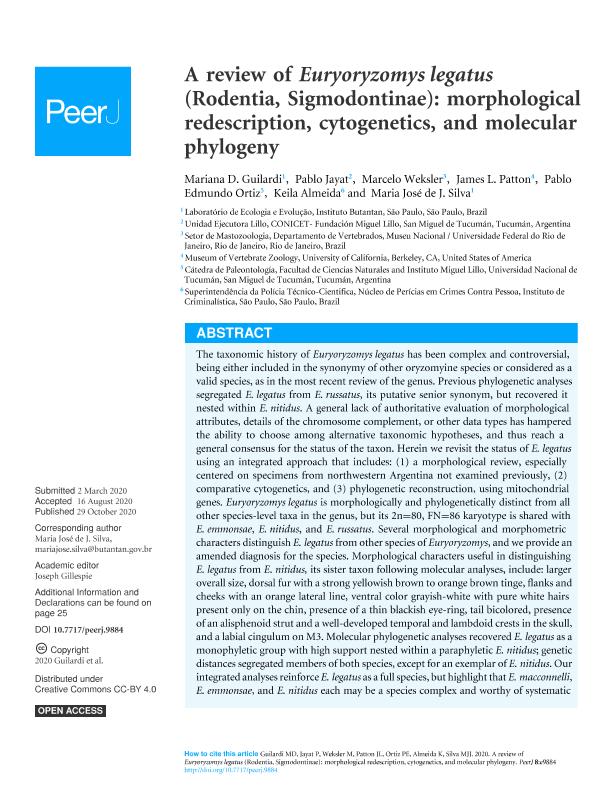Mostrar el registro sencillo del ítem
dc.contributor.author
Guilardi, Mariana D.
dc.contributor.author
Jayat, Jorge Pablo

dc.contributor.author
Weksler, Marcelo

dc.contributor.author
Patton, James L.
dc.contributor.author
Ortiz, Pablo Edmundo

dc.contributor.author
Almeida, Keila
dc.contributor.author
De Silva, Maria José
dc.date.available
2021-10-08T15:46:40Z
dc.date.issued
2020-10
dc.identifier.citation
Guilardi, Mariana D.; Jayat, Jorge Pablo; Weksler, Marcelo; Patton, James L.; Ortiz, Pablo Edmundo; et al.; A review of euryoryzomys legatus (Rodentia, sigmodontinae): Morphological redescription, cytogenetics, and molecular phylogeny; PeerJ Inc.; PeerJ; 8; 10-2020
dc.identifier.issn
2167-8359
dc.identifier.uri
http://hdl.handle.net/11336/143245
dc.description.abstract
The taxonomic history of Euryoryzomys legatus has been complex and controversial, being either included in the synonymy of other oryzomyine species or considered as a valid species, as in the most recent review of the genus. Previous phylogenetic analyses segregated E. legatus from E. russatus, its putative senior synonym, but recovered it nested within E. nitidus. A general lack of authoritative evaluation of morphological attributes, details of the chromosome complement, or other data types has hampered the ability to choose among alternative taxonomic hypotheses, and thus reach a general consensus for the status of the taxon. Herein we revisit the status of E. legatus using an integrated approach that includes: (1) a morphological review, especially centered on specimens from northwestern Argentina not examined previously, (2) comparative cytogenetics, and (3) phylogenetic reconstruction, using mitochondrial genes. Euryoryzomys legatus is morphologically and phylogenetically distinct from all other species-level taxa in the genus, but its 2n=80, FN=86 karyotype is shared with E. emmonsae, E. nitidus, and E. russatus. Several morphological and morphometric characters distinguish E. legatus from other species of Euryoryzomys, and we provide an amended diagnosis for the species. Morphological characters useful in distinguishing E. legatus from E. nitidus, its sister taxon following molecular analyses, include: larger overall size, dorsal fur with a strong yellowish brown to orange brown tinge, flanks and cheeks with an orange lateral line, ventral color grayish-white with pure white hairs present only on the chin, presence of a thin blackish eye-ring, tail bicolored, presence of an alisphenoid strut and a well-developed temporal and lambdoid crests in the skull, and a labial cingulum on M3. Molecular phylogenetic analyses recovered E. legatus as a monophyletic group with high support nested within a paraphyletic E. nitidus; genetic distances segregated members of both species, except for an exemplar of E. nitidus. Our integrated analyses reinforce E. legatus as a full species, but highlight that E. macconnelli, E. emmonsae, and E. nitidus each may be a species complex and worthy of systematic attention. Finally, we also evaluated the chromosome evolution of the genus within a phylogenetic context.
dc.format
application/pdf
dc.language.iso
eng
dc.publisher
PeerJ Inc.
dc.rights
info:eu-repo/semantics/openAccess
dc.rights.uri
https://creativecommons.org/licenses/by/2.5/ar/
dc.subject
CRICETIDAE
dc.subject
INTEGRATIVE TAXONOMY
dc.subject
KARYOTYPE
dc.subject
MOLECULAR SYSTEMATICS
dc.subject
MORPHOLOGY
dc.subject
NEOTROPICS
dc.subject
ORYZOMYINI
dc.subject
RODENTS
dc.subject.classification
Otros Tópicos Biológicos

dc.subject.classification
Ciencias Biológicas

dc.subject.classification
CIENCIAS NATURALES Y EXACTAS

dc.title
A review of euryoryzomys legatus (Rodentia, sigmodontinae): Morphological redescription, cytogenetics, and molecular phylogeny
dc.type
info:eu-repo/semantics/article
dc.type
info:ar-repo/semantics/artículo
dc.type
info:eu-repo/semantics/publishedVersion
dc.date.updated
2021-09-07T14:41:22Z
dc.journal.volume
8
dc.journal.pais
Estados Unidos

dc.journal.ciudad
Lawrence
dc.description.fil
Fil: Guilardi, Mariana D.. Laboratório de Ecologia E Evolucão, Instituto Butantan; Brasil
dc.description.fil
Fil: Jayat, Jorge Pablo. Consejo Nacional de Investigaciones Científicas y Técnicas. Centro Científico Tecnológico - Tucumán. Unidad Ejecutora Lillo; Argentina
dc.description.fil
Fil: Weksler, Marcelo. Museu Nacional / Universidade Federal Do Rio de Janeiro; Brasil
dc.description.fil
Fil: Patton, James L.. University of California. Department of Integrative Biology. Museum of Vertebrate Zoology; Estados Unidos
dc.description.fil
Fil: Ortiz, Pablo Edmundo. Consejo Nacional de Investigaciones Científicas y Técnicas. Centro Científico Tecnológico Conicet - Tucumán. Instituto Superior de Correlación Geológica. Universidad Nacional de Tucumán. Facultad de Ciencias Naturales e Instituto Miguel Lillo. Departamento de Geología. Cátedra Geología Estructural. Instituto Superior de Correlación Geológica; Argentina
dc.description.fil
Fil: Almeida, Keila. Instituto de Criminalística São Paulo; Brasil
dc.description.fil
Fil: De Silva, Maria José. Laboratório de Ecologia E Evolucão, Instituto Butantan; Brasil
dc.journal.title
PeerJ
dc.relation.alternativeid
info:eu-repo/semantics/altIdentifier/url/https://peerj.com/articles/9884
dc.relation.alternativeid
info:eu-repo/semantics/altIdentifier/doi/http://dx.doi.org/10.7717/peerj.9884
Archivos asociados
